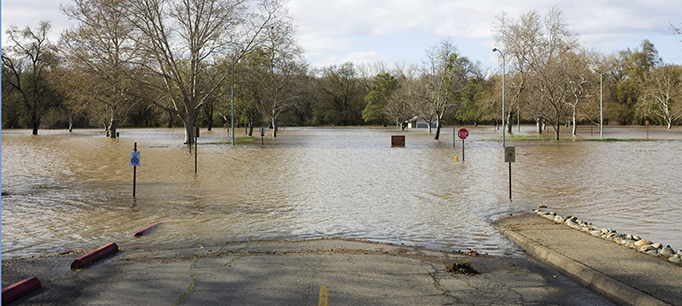The Assembly Water, Parks, and Wildlife Committee held its first hearing of the new legislative session yesterday. As a reminder that California is never more than one big storm away from flood problems—even when reeling from a multi-year drought—the hearing’s topic was flood management. A particular focus was the state’s role in supporting flood protection infrastructure using funds authorized by Proposition 1E, a $4.1 billion general obligation bond approved by state voters in November 2006.
I provided the committee with an introductory overview of California’s challenges in addressing growing flood risk. I began with some summary information on the extent and nature of the risk: Roughly 21 percent of California’s population lives in areas vulnerable to flooding, with 4 percent at extreme risk. This is a problem that affects all regions of the state—especially the Sacramento and San Joaquin Valleys and coastal areas. Risk is growing as the population grows, putting more people in harm’s way. A rising sea level and a changing climate—with warmer winters and more variable conditions—are also increasing California’s vulnerability to flooding.
California has a vast flood management system, overseen by federal, state, and local agencies. But this system faces significant challenges–including a large investment gap, with spending lagging far behind needs. In addition, state taxpayers face potentially high liabilities from levee failures within the Central Valley since a 2003 court ruling (the Paterno decision). And while improving flood infrastructure such as levees can reduce the frequency of floods, it doesn’t eliminate risk. If new development is allowed in places with the relatively low level of protection required by federal standards (against the “100-year flood”—a flood with a 1 percent chance of occurring in any given year), the total economic and social risk of flooding can actually increase. Flood insurance is a way to cushion against this remaining risk, but few Californians take advantage of this option.
In a recent study, PPIC took a closer look at the flood investment gap. We found that although the recent infusion of state bond funds has helped, California’s flood investments are still seriously lagging. California needs to raise an additional $800 million to $1 billion per year to undertake these investments within a reasonable time frame (25 years). Federal contributions are small (just $250 million/year in recent years), and likely to decline in the future. So the gap will need to be filled by state and local sources. In the very near-term, the state can step up with remaining bond funds. The governor’s budget proposes spending the remaining $1.1 billion in Prop 1E funds next year. Proposition 1—the new state bond approved by voters in November 2014—provides an additional $395 million for flood protection. Beyond this, the solutions lie in making it easier for local agencies to raise funds and identifying new state funding sources.
To reduce risk, the state should also consider extending reforms enacted for the Central Valley in 2007—which set higher protection standards for urban areas—to other flood-prone regions. One of the best defenses against flooding is land-use planning that keeps people out of harm’s way.


